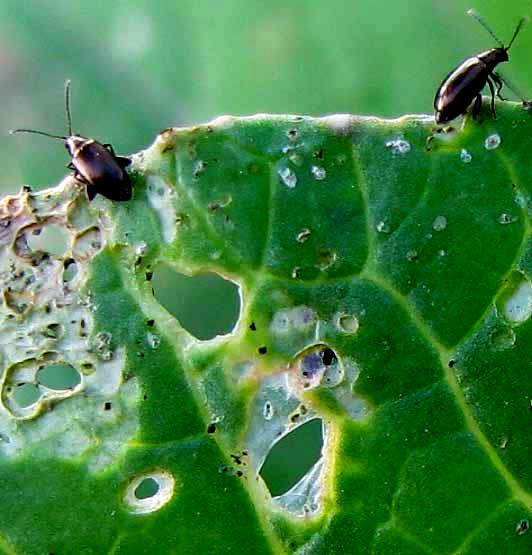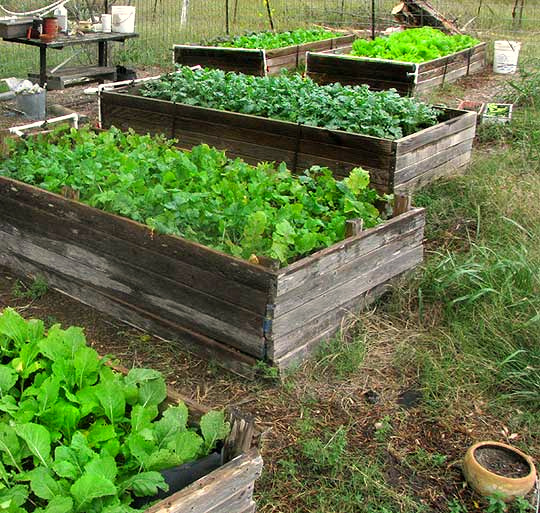Excerpts from Jim Conrad's
Naturalist Newsletter

from the October 28, 2012 Newsletter issued from the valley of the Dry Frio River in northern Uvalde County, southwestern Texas, on the southern border of the Edwards Plateau; elevation ~1750m (~5750 ft); N29.62°, W99.86°; USA
FLEA BEETLE ATTACK
The day after I arrived here two months ago I planted a winter garden in the five raised beds next to the cabin. Now the beds are producing all the greens and salad ingredients we can eat. You can see the beds below.

There you see, from bottom left upward, mustard greens, turnips, Japanese radishes, then in the background Chinese cabbage at the right and at the left bok choy, tat soi and cilantro. In the main garden there are other crops, such as spinach, kohlrabi, onions, lettuce, many more turnips, and even tomato vines bearing egg-sized green tomatoes.
One problem with the plants in the five raised beds is that everything in them except the cilantro is a member of the Mustard Family. In other words, I've almost created a monoculture there, and monocultures always are ecologically unstable. When you make monocultures, you're just asking for trouble.
So far there's been little problem with insects -- until this week, on the same day the Cactus Bugs appeared in such large numbers. Then, in a matter of two days, suddenly there was a population explosion of tiny black beetles that left every leaf in the picture -- except, oddly, those of the Japanese radishes -- punctured with many holes. When I put my nose up to a leaf to identify the beetle doing the damage, it helped me figure out who it was by simply disappearing from where it'd been. It had jumped away so fast that my brain couldn't register its movement. Therefore: It was a beetle that jumped like a flea, so my beds were plagued by flea beetles! You can see a couple of them, their bodies only about 3/16ths of an inch long (2mm), and some of the damage they cause to leaves, at the top of this page.
On the Internet it was easy enough to identify this flea beetle infesting members of the Mustard Family. It's the Crucifer Flea Beetle, PHYLLOTRETA CRUCIFERAE, the word "crucifer" deriving from the old name of the Mustard Family, the Crucifereae. Now the Mustard Family is called the Brassicaceae, so people have begun speaking of "brassicaceous" crops instead of "cruciferous" ones. Anyway, Crucifer Flea Beetles are native to Eurasia but now are spread throughout North America.
In the above photo you wonder how such tiny insects could create such large holes in the leaves. What happens is that the insects eat emerging leaves when they are tender and small. Small holes in small leaves become large holes when the leaves grow large.
The best way to avoid infestation by Crucifer Flea Beetles is to separate brassicaceous crops by plantings of members of other families -- to avoid creating a monoculture. Also, brassicaceous crops should be alternated with non-brassicaceous ones year after year. The problem is that for winter gardens the preponderance of eligible crops are brassicaceous. Once you have Crucifer Flea Beetles, they're hard to get rid of without using hard chemicals. Studies show that organic pyrethrin doesn't keep the beetles from feeding, nor does treatment of plants with kaolin, and even vacuuming them off doesn't control them.
Hopefully, colder weather will take care of them.
Scattered around Uvalde at this time of year are large, circular, irrigated fields of cabbage, which are sprayed by airplanes. I'm wondering if maybe this has something to do with my own infestation.